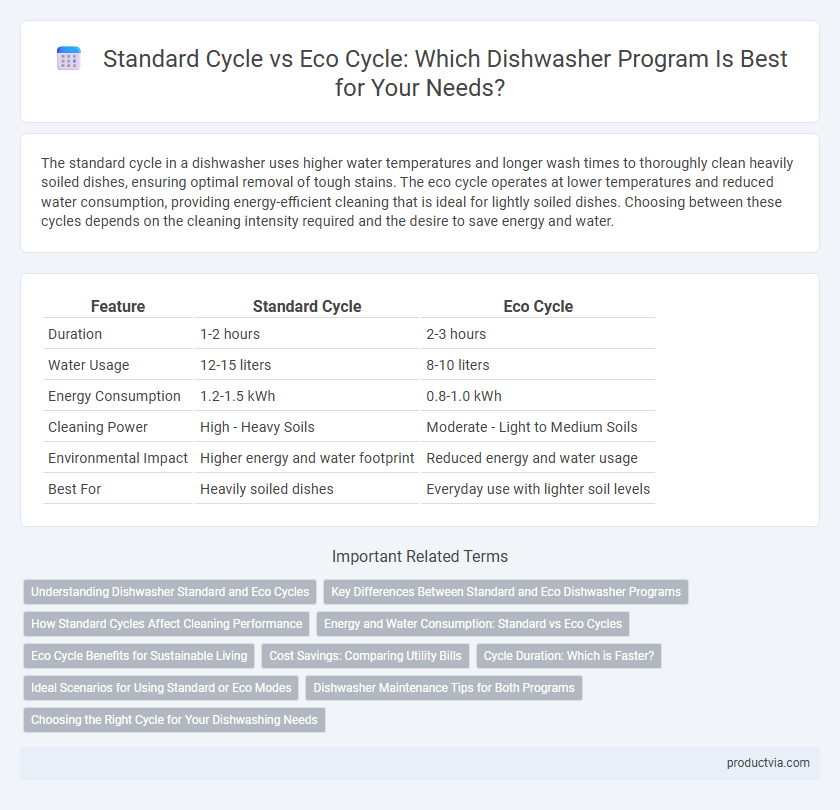The standard cycle in a dishwasher uses higher water temperatures and longer wash times to thoroughly clean heavily soiled dishes, ensuring optimal removal of tough stains. The eco cycle operates at lower temperatures and reduced water consumption, providing energy-efficient cleaning that is ideal for lightly soiled dishes. Choosing between these cycles depends on the cleaning intensity required and the desire to save energy and water.
Table of Comparison
| Feature | Standard Cycle | Eco Cycle |
|---|---|---|
| Duration | 1-2 hours | 2-3 hours |
| Water Usage | 12-15 liters | 8-10 liters |
| Energy Consumption | 1.2-1.5 kWh | 0.8-1.0 kWh |
| Cleaning Power | High - Heavy Soils | Moderate - Light to Medium Soils |
| Environmental Impact | Higher energy and water footprint | Reduced energy and water usage |
| Best For | Heavily soiled dishes | Everyday use with lighter soil levels |
Understanding Dishwasher Standard and Eco Cycles
Dishwasher standard cycles typically use higher water temperatures and longer wash times to ensure thorough cleaning and sanitation, ideal for heavily soiled dishes. Eco cycles optimize energy and water consumption by using lower temperatures and reduced cycles, promoting environmental sustainability without significantly compromising cleaning performance. Understanding the balance between cleaning efficiency and resource conservation helps users select the appropriate cycle for varying dishwashing needs.
Key Differences Between Standard and Eco Dishwasher Programs
The Standard dishwasher cycle uses higher water temperatures and longer wash times to ensure thorough cleaning and sanitization, making it ideal for heavily soiled dishes. The Eco cycle operates at lower temperatures and reduces water and energy consumption, prioritizing environmental efficiency while delivering adequate cleaning for lightly soiled items. Key differences include energy usage, water temperature, cycle duration, and environmental impact, with the Standard cycle favoring performance and the Eco cycle focusing on sustainability.
How Standard Cycles Affect Cleaning Performance
Standard dishwasher cycles use higher water temperatures and longer wash durations, resulting in more thorough removal of tough stains and baked-on food. This intensive cleaning method consumes more energy and water compared to Eco cycles but ensures optimal hygienic performance and spotless dishes. Standard cycles are ideal for heavily soiled loads where superior cleaning and sanitation are a priority.
Energy and Water Consumption: Standard vs Eco Cycles
The Standard cycle in dishwashers typically uses more water and energy, averaging around 12-15 liters and 1.5 kWh per wash, whereas the Eco cycle reduces consumption to approximately 8-10 liters and 0.8-1 kWh by extending wash time and lowering temperature. Energy-efficient Eco cycles optimize water heating and spray patterns, significantly cutting utility costs and environmental impact compared to Standard settings. Choosing the Eco cycle aligns with sustainability goals by minimizing resource usage while still maintaining effective cleaning performance.
Eco Cycle Benefits for Sustainable Living
The Eco cycle in dishwashers uses lower temperatures and reduced water consumption compared to the standard cycle, significantly decreasing energy usage and utility bills. This cycle optimizes detergent efficiency while maintaining effective cleaning, making it an environmentally friendly choice. Utilizing the Eco cycle supports sustainable living by minimizing the carbon footprint associated with household chores.
Cost Savings: Comparing Utility Bills
The standard dishwasher cycle typically uses more water and energy, resulting in higher electricity and water bills compared to the eco cycle. Eco cycles operate at lower temperatures and extend wash durations, significantly reducing utility consumption and lowering monthly costs. Households using eco cycles can expect up to 30% savings on energy bills while maintaining effective cleaning performance.
Cycle Duration: Which is Faster?
The Standard cycle in dishwashers typically runs between 90 to 120 minutes, offering thorough cleaning with a moderate water and energy usage. The Eco cycle, designed for energy efficiency, generally extends the duration to 150 to 180 minutes to decrease water temperature and consumption for sustainable cleaning. Choosing between these cycles depends on the priority for speed or environmental impact, with the Standard cycle being notably faster.
Ideal Scenarios for Using Standard or Eco Modes
The Standard cycle is ideal for heavily soiled dishes and cookware, delivering a thorough clean with higher water temperature and stronger spray pressure. The Eco cycle suits lightly soiled items and daily dishwashing, using less water and energy while extending the appliance's lifespan. Choosing the appropriate mode balances cleaning efficiency with environmental benefits in various usage scenarios.
Dishwasher Maintenance Tips for Both Programs
Regularly clean the dishwasher filter and spray arms to maintain optimal performance for both standard and eco cycles. Use a dishwasher-safe cleaner monthly to prevent buildup and odors, ensuring efficient water and energy use for each program. Check and replace rubber seals as needed to avoid leaks and maintain dishwasher efficiency regardless of the cycle selected.
Choosing the Right Cycle for Your Dishwashing Needs
The standard cycle in dishwashers uses higher water temperatures and more detergent to effectively remove heavy food residues, ideal for pots, pans, and heavily soiled dishes. The eco cycle operates at lower temperatures with reduced water and energy consumption, making it suitable for lightly soiled dishes and environmentally conscious users. Selecting the appropriate cycle depends on the soil level of your dishes and your priorities between thorough cleaning and energy efficiency.
Standard cycle vs Eco cycle for dishwasher program Infographic

 productvia.com
productvia.com